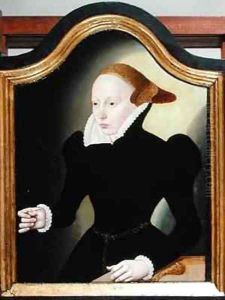Bartholomaus the Younger Bruyn Paintings
Bartholomäus Bruyn the Younger was a German painter, born in 1530 in Cologne. He was the son of Bartholomäus Bruyn the Elder, who was a prominent portrait painter of the Cologne school during the German Renaissance. Following in his father's footsteps, Bruyn the Younger became known for his own contributions to portrait painting and his continuation of the family workshop tradition.
Bruyn the Younger's early life was spent in his father's workshop, where he was trained in the arts of painting and drawing. Under his father's guidance, he developed a keen eye for detail and a talent for capturing the likenesses and personalities of his subjects. Although he lived and worked during the period of the Reformation, which greatly affected the arts in Germany, he maintained a focus on the traditional values of portrait painting, which was less impacted by religious turmoil compared to other genres such as altarpieces or religious imagery.
After his father's death in 1555, Bruyn the Younger took over the family workshop. His style did not diverge significantly from that of his father, and he continued to produce finely detailed portraits. His clientele was primarily the wealthy middle-class citizens of Cologne, as well as the local nobility. Unlike his father, who had connections with the court of Duke Wilhelm V of Jülich-Cleves-Berg, there is less evidence to suggest that Bruyn the Younger worked extensively for the nobility or for patrons outside of Cologne.
Bruyn the Younger's works are characterized by their precise brushwork and often include intricate details of clothing and jewelry, indicative of the sitters' status and wealth. His portraits are typically bust-length or half-length, set against a neutral background, which was a common convention of the time.
Despite his skills as a portraitist, Bruyn the Younger did not achieve the same level of fame as his father and was somewhat overshadowed by the elder Bruyn's reputation. Nevertheless, he was an important figure in maintaining the standards of portrait painting in Cologne during the late 16th century. Bruyn the Younger died in 1610 in Cologne, leaving behind a body of work that, while less known, contributes to the rich tapestry of Renaissance art in Germany.
